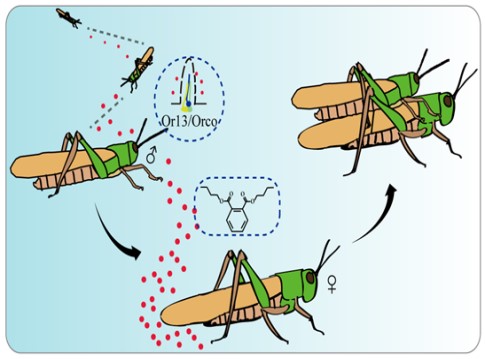Locusts are important agricultural pests that cause severe agricultural disasters and economic losses. In the natural environment, the population density of locusts can vary greatly, ranging from sporadic individuals to high-density swarms. The decrease in population density of insects often meets great challenges for their survival and reproduction. Gregarious locusts release 4VA as an aggregation pheromone to attract conspecifics and form groups (Guo et al., 2020, Nature). In contrast, in low-density populations, mating opportunities are significantly reduced. This has sparked researchers’ curiosity about whether there are specific signals for finding mates in locusts within low densities.
On July 17, 2024, the team of Prof. Kang Le and Prof. Wang Xianhui from the Institute of Zoology, Chinese Academy of Sciences, in collaboration, published in PNAS titled "Dibutyl phthalate released by solitary female locusts mediates sexual communication at low density". This study made an intriguing discovery that the compound dibutyl phthalate (DBP) functions as a sex pheromone released by female solitary locusts promotes sooner mate location at low density.
In this study, they found a true sex pheromone from orthopteran insects with strict criteria in laboratory and field cage experiments. The DBP, an aromatic chemical released by female solitary locusts, is identified as a sex pheromone of the migratory locust. They employed multidisciplinary approaches to identify LmigOr13 as the sex pheromone receptor expressed in neuron housed in the basiconic sensilla. Notably, the LmigOr13-/- mutants, generated by CRISPR/Cas9, exhibit a loss of behavioral attractiveness to male locusts in laboratory and field experiments.
This study reveals an intriguing mechanism in which sex pheromones play a more crucial role in solitary locusts than gregarious locusts, in finding mates at low densities, thereby achieving behavioral fitness and reproductive success. Thus, their study expands the molecular phenotypes of olfactory signals between solitary and gregarious locusts and opens up new perspectives for further study on the relation between insect communication and population density. The discovery of sex pheromones opens up new possibilities for monitoring locust populations. DBP and its corresponding odorant receptor present promising targets for the development of active pesticides against locust plagues.

DBP promotes solitary male locusts sooner mate location at low population densities.
(Image by Cui Weichan)
Paper link: https://www.pnas.org/doi/10.1073/pnas.2401926121

